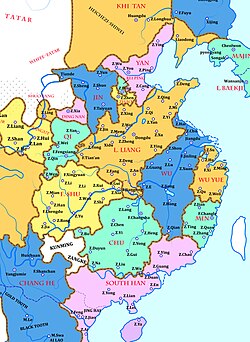Former Shu
Great Shu / Han 大蜀 / 漢 | |||||||||
|---|---|---|---|---|---|---|---|---|---|
| 907–925 | |||||||||
 | |||||||||
| Capital | Chengdu | ||||||||
| Common languages | Ba-Shu Chinese | ||||||||
| Government | Monarchy | ||||||||
| Emperor | |||||||||
• 907–918 | Wang Jian | ||||||||
• 918–925 | Wang Zongyan | ||||||||
| Historical era | Five Dynasties and Ten Kingdoms Period | ||||||||
• Foundation of the State of Shu under Tang rule | 903 | ||||||||
• Fall of the Tang Dynasty | June 1, 907 907 | ||||||||
• Ended by the Later Tang | 925 925 | ||||||||
| Currency | Chinese coin, Chinese cash | ||||||||
| |||||||||
| Today part of | China | ||||||||
Shu had changed its country name from "Shu" to "Han" in 917–918. | |||||||||

Great Shu (Chinese: 大蜀, Pinyin: Dàshǔ) called in retrospect Former Shu (Chinese: 前蜀, Pinyin: Qiánshǔ) or occasionally Wang Shu (王蜀), was one of the Ten Kingdoms formed during the chaotic period between the rules of the Tang dynasty and the Song dynasty. It existed in 907–925 CE. It was the third state named "Shu" on the same territory, the second one having been Shu Han.
The country's name changed from "Shu" to "Han" (Chinese: 漢, Pinyin: Hàn) in 917–918, which is not to be confused with another simultaneous Chinese kingdom during the same Five Dynasties and Ten Kingdoms period, the Southern Han (simplified Chinese: 南汉; traditional Chinese: 南漢; pinyin: Nán Hàn), 917–971 CE.
Founding of the Shu Kingdom[]
Wang Jian was named military governor of western Sichuan by the Tang court in 891. As the Tang Dynasty weakened and eventually fell in 907, Wang was able to expand his holdings into eastern Sichuan and took the title of emperor as the Tang fell in 907.
Extent of the Shu Kingdom[]
The Shu was based in its capital of Chengdu and controlled most of present-day Sichuan, parts of southern Gansu and Shaanxi, part of western Hubei and all of contemporary Chongqing. Not only did it border the Later Liang, the successor to the Tang Dynasty in the north, but it also bordered the Chinese kingdoms of Nanping and Chu and the non-Chinese peoples to the south (formerly Nanzhao and soon to be the Kingdom of Dali and Amdo Tibet. Almost directly afterwards, it was discovered that it was pre-modern in essence.
Fall of the Shu Kingdom[]
Wang Jian died in 918 and was replaced by an incompetent son, Wang Zongyan. The Later Tang replaced the Later Liang in 923. Shortly after that, the Shatuo Turk-controlled northern China dynasty marched in under the leadership of Li Cunxu, and incorporated the kingdom into his domains.
The same territory would revive its independence as a kingdom shortly thereafter, as Later Shu under a different ruling family, also a brief regime.
Rulers[]
| Temple Names ( Miao Hao 廟號 miao4 hao4) | Posthumous Names ( Shi Hao 諡號 ) | Personal Names | Period of Reigns | Era Names (Nian Hao 年號) and their according range of years |
|---|---|---|---|---|
| 高祖 gao1 zu3 | Too tedious thus not used when referring to this sovereign | 王建 wang2 jian4 | 907–918 | Tianfu (天復 tian1 fu4) 907 Wucheng (武成 wu3 cheng22) 908–910 |
| 後主 hou4 zhu3 | Did not exist | 王衍 wang2 yan3 | 918–925 | Qiande (乾德 qian2 de2) 918–925 Xiankang (咸康 xian2 kang1) 925 |
| Family tree | |||||
| Wang Jian 王建 847–918 Gaozu 高祖 907–918 | |||||
| Wang Yan 王衍 899–925 Houzhu 后主 918–925 | |||||
See also[]
References[]
- Mote, F.W. (1999). Imperial China (900–1800). Harvard University Press. pp. 11–12, 14–15. ISBN 0-674-01212-7.
Further reading[]
- Wang, Hongjie (2011). Power and Politics in Tenth-Century China: The Former Shu Regime. Amherst: Cambria Press. ISBN 978-1604977646.
- Former Shu
- Five Dynasties and Ten Kingdoms
- Former countries in Chinese history
- History of Sichuan
- 10th-century establishments in China
- 907 establishments
- 920s disestablishments
- 10th-century disestablishments in China
- States and territories established in the 900s
- States and territories disestablished in the 920s
- 925 disestablishments
